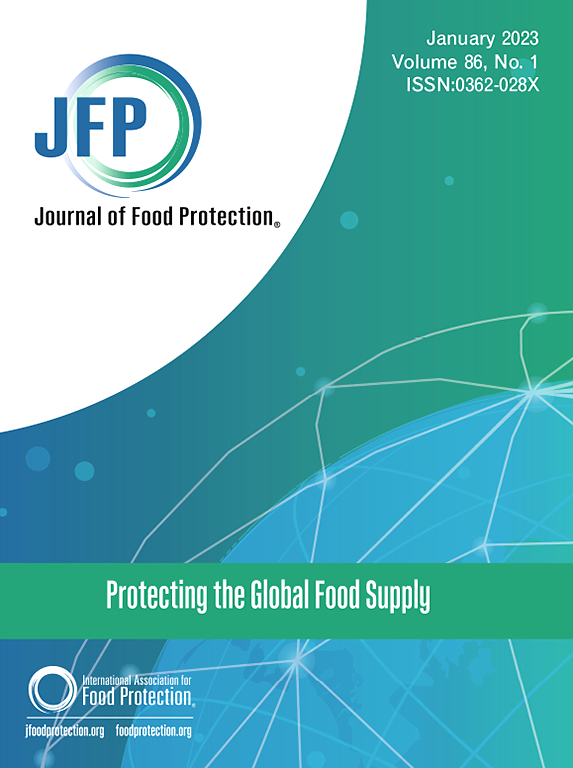美国屠宰场内和屠宰场之间肉鸡沙门氏菌血清型的差异
IF 2.8
4区 农林科学
Q3 BIOTECHNOLOGY & APPLIED MICROBIOLOGY
引用次数: 0
摘要
肠道沙门氏菌有2500多种血清型。这种细菌的一个有趣特征是,无论样本是从食品、单一动物物种、人类还是特定环境中收集的,只有大约5种血清型占所有阳性样本的50%或更多。沙门氏菌的另一个有趣的特征是,最常见的血清型在不同的时间或广泛的地理区域并不一致。这种现象的例子是,1996年,海德堡沙门氏菌是美国人类疾病病例中发现的第三种最常见的血清型,但到2022年,它是第53种最常见的血清型。血清型特异性空间聚类的一个例子是主要发生在东南亚大陆的welteveden沙门氏菌。在空间和时间上的聚集提供了控制更多致病血清型的机会。在这项研究中,使用了对美国肉鸡胴体生产进行的为期7个月的调查数据,以评估随着胴体在生产过程中的移动,优势血清型的发生情况如何变化。在热挂和冷后采集样本,每个地点的阳性样本数分别为2909和233。不同的干预策略可能对特定血清型产生不同的影响。其他分析表明,血清型是如何作为产量和公司所有权的函数聚集(或不聚集)的。了解整个行业中血清型的发生如何变化,可以深入了解导致特定血清型聚集的因素,并有可能帮助确定有效降低人类沙门氏菌病风险的干预策略。本文章由计算机程序翻译,如有差异,请以英文原文为准。
Differences in Salmonella Serotypes in Broiler Chickens Within and Between Slaughter Establishments in the United States
There are more than 2500 serotypes of Salmonella enterica. One interesting feature of this bacterium is that regardless of whether samples are collected from food commodities, a single animal species, humans, or a specific environmental setting, only about 5 serotypes constitute 50% or more of all positive samples. Another interesting feature of Salmonella is that the most common serotypes are not consistent across time or broad geographic region. Examples of this phenomenon are that Salmonella Heidelberg was the third most common serotype found in United States human illness cases in 1996, but the 53rd most common serotype in 2022. An example of serotype-specific spatial clustering is the occurrence of Salmonella Weltevreden predominantly in continental Southeast Asia. Clustering in space and time presents opportunities to control more pathogenic serotypes. In this study, data from a seven-month survey of broiler chicken carcass production in the United States are used to assess how the occurrence of the dominant serotypes changes as carcasses move through the production process. Samples were collected at rehang and postchill, with the number of positive samples at each location being 2909 and 233, respectively. Different intervention strategies may impact specific serotypes differently. Additional analyses demonstrate how serotypes are clustered (or not) as a function of production volume and corporate ownership. Understanding how the occurrence of serotypes varies across the industry can provide insights into factors that lead to the clustering of specific serotypes and has the potential to help identify intervention strategies that effectively reduce the risk of human salmonellosis.
求助全文
通过发布文献求助,成功后即可免费获取论文全文。
去求助
来源期刊

Journal of food protection
工程技术-生物工程与应用微生物
CiteScore
4.20
自引率
5.00%
发文量
296
审稿时长
2.5 months
期刊介绍:
The Journal of Food Protection® (JFP) is an international, monthly scientific journal in the English language published by the International Association for Food Protection (IAFP). JFP publishes research and review articles on all aspects of food protection and safety. Major emphases of JFP are placed on studies dealing with:
Tracking, detecting (including traditional, molecular, and real-time), inactivating, and controlling food-related hazards, including microorganisms (including antibiotic resistance), microbial (mycotoxins, seafood toxins) and non-microbial toxins (heavy metals, pesticides, veterinary drug residues, migrants from food packaging, and processing contaminants), allergens and pests (insects, rodents) in human food, pet food and animal feed throughout the food chain;
Microbiological food quality and traditional/novel methods to assay microbiological food quality;
Prevention of food-related hazards and food spoilage through food preservatives and thermal/non-thermal processes, including process validation;
Food fermentations and food-related probiotics;
Safe food handling practices during pre-harvest, harvest, post-harvest, distribution and consumption, including food safety education for retailers, foodservice, and consumers;
Risk assessments for food-related hazards;
Economic impact of food-related hazards, foodborne illness, food loss, food spoilage, and adulterated foods;
Food fraud, food authentication, food defense, and foodborne disease outbreak investigations.
 求助内容:
求助内容: 应助结果提醒方式:
应助结果提醒方式:


